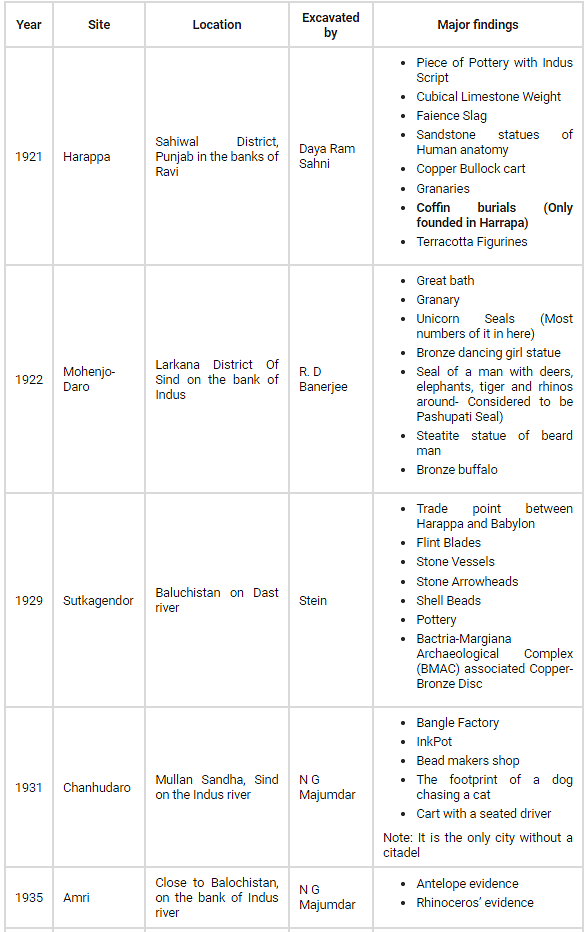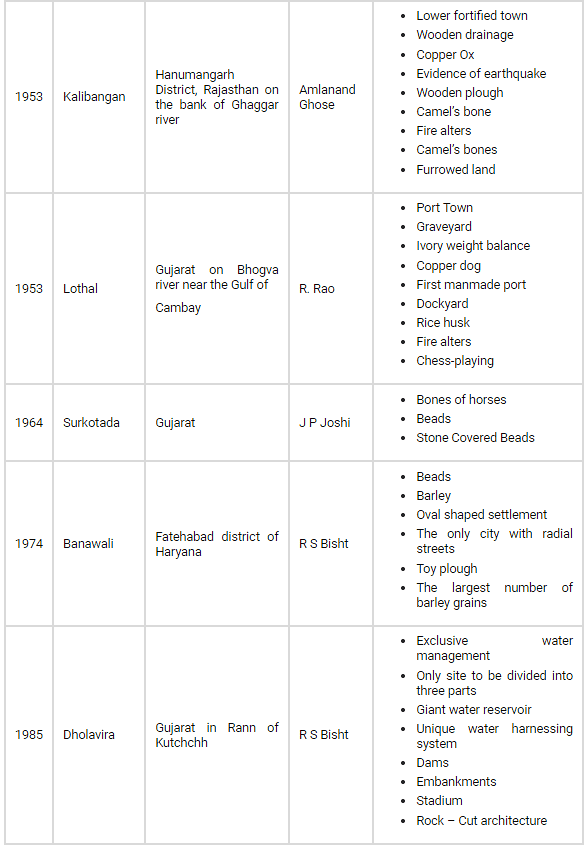Indus Civilization | Anthropology Optional for UPSC PDF Download
Introduction
- The history of India begins with the birth of the Indus Valley Civilization (IVC), also known as Harappan Civilization.
- It flourished around 2,500 BC, in the western part of South Asia, in contemporary Pakistan and Western India.
- The Indus Valley was home to the largest of the four ancient urban civilizations of Egypt, Mesopotamia, India and China.
- In 1920s, the Archaeological Department of India carried out excavations in the Indus valley wherein the ruins of the two old cities, viz. Mohenjodaro and Harappa were unearthed.
- In 1924, John Marshall, Director-General of the ASI, announced the discovery of a new civilisation in the Indus valley to the world.


Phases of IVC
- Three phases of IVC are:
- the Early Harappan Phase from 3300 to 2600 BCE,
- the Mature Harappan Phase from 2600 to 1900 BCE, and
- the Late Harappan Phase from 1900 to 1300 BCE.
- The Early Harappan Phase is related to the Hakra Phase, identified in the Ghaggar-Hakra River Valley.
- The earliest examples of the Indus script date back to 3000 BC.
- This phase stands characterized by centralized authority and an increasingly urban quality of life.
- Trade networks had been established and there are also evidences of the cultivation of crops. Peas, sesame seeds, dates, cotton, etc, were grown during that time.
- Kot Diji represents the phase leading up to Mature Harappan Phase.
- By 2600 BC, the Indus Valley Civilization had entered into a mature stage.
- The early Harappan communities were turning into large urban centers, like Harappa and Mohenjodaro in Pakistan and Lothal in India.
- The signs of a gradual decline of the Indus River Valley Civilization are believed to have started around 1800 BC and by 1700 BC, most of the cities were abandoned.
- However, one can see the various elements of the Ancient Indus Valley Civilization in later cultures.
- Archaeological data indicates the persistence of the Late Harappan culture till 1000-900 BC.
Town Planning and Structures
- The Harappan culture was distinguished by its system of town planning.
- Harappa and Mohenjodaro each had its own citadel or acropolis, which was possibly occupied by members of the ruling class.
- Below the citadel in each city lay a lower town containing brick houses, which were inhabited by the common people.
- The remarkable thing about the arrangement of the houses in the cities is that they followed the grid system.
- Granaries constituted an important part of the Harappan cities.
- The use of burnt bricks in the Harappan cities is remarkable, because in the contemporary buildings of Egypt mainly dried bricks were used.
- The drainage system of Mohenjodaro was very impressive.
- In almost all cities every big or small house had its own courtyard and bathroom.
- In Kalibangan many houses had their wells.
- At sites such as Dholavira and Lothal (Gujarat), the entire settlement was fortified, and sections within the town were also separated by walls.
Agriculture
- The Harappan villages, mostly situated near the flood plains, produced sufficient foodgrains.
- Wheat, barley, rai, peas, sesame, lentil, chickpea and mustard were produced. Millets are also found from sites in Gujarat. While rice uses were relatively rare.
- The Indus people were the earliest people to produce cotton.
- While the prevalence of agriculture is indicated by finds of grain, it is more difficult to reconstruct actual agricultural practices.
- Representations on seals and terracotta sculpture indicate that the bull was known, and archaeologists extrapolate shows oxen were also used for ploughing.
- Most Harappan sites are located in semi-arid lands, where irrigation was probably required for agriculture.
- Traces of canals have been found at the Harappan site of Shortughai in Afghanistan, but not in Punjab or Sindh.
- Although the Harappans practised agriculture, animals were also reared on a large scale.
- Evidence of the horse comes from a superficial level of Mohenjodaro and from a doubtful terracotta figurine from Lothal. In any case the Harappan culture was not horse centred.
Economy
- The importance of trade in the life of the Indus people is witnessed by the presence of numerous seals, uniform script and regulated weights and measures in a wide area.
- The Harappans carried on considerable trade in stone, metal, shell, etc.
- Metal money was not used and trade was carried by barter system.
- They practised navigation on the coast of the Arabian Sea.
- They had set up a trading colony in northern Afghanistan which evidently facilitated trade with Central Asia.
- They also carried commerce with those in the land of the Tigris and the Euphrates.
- The Harappans carried on long distance trade in lapis lazuli; which may have contributed to the social prestige of the ruling class.
Crafts
- The Harappans were very well acquainted with the manufacturing and use of Bronze.
- Copper was obtained from the Khetri copper mines of Rajasthan and Tin was possibly brought from Afghanistan.
- Textile impressions have also been found on several objects.
- Huge brick structure suggest that brick-laying was an important craft. This also attests the existence of a class of masons.
- The Harappans practised boat-making, bead making and seal-making. Terracotta manufacture was also an important craft.
- The goldsmiths made jewellery of silver, gold and precious stones.
- The potter's wheel was in full use, and the Harappans produced their own characteristic pottery, which was glossy and shining.
Institutions
- Very few written materials have been discovered in the Indus valley and the scholars have not been able to decipher the Indus script so far.
- As a result, there is difficulty in understanding the nature of the state and institutions of the Indus Valley Civilization.
- No temples have been found at any Harappan sites. Therefore the possibility of priests ruling Harappa can be eliminated.
- Harappa was possibly ruled by a class of merchants.
- If we look for a centre of power or for depictions of people in power, archaeological records provide no immediate answers.
(i) Some archaeologists are of the opinion that Harappan society had no rulers, and that everybody enjoyed equal status.
(ii) Another theory argues that there was no single ruler, but a number of rulers representing each of the urban centers.
Religion
- In Harappa numerous terracotta figurines of women have been found. In one figurine a plant is shown growing out of the embryo of a woman.
- The Harappans, therefore, looked upon the earth as a fertility goddess and worshipped her in the same manner as the Egyptians worshipped the Nile goddess Isis.
- The male deity is represented on a seal with three horned heads, represented in the sitting posture of a yogi.
- This god is surrounded by an elephant, a tiger, a rhinoceros, and has a buffalo below his throne. At his feet appear two deer.The depicted god is identified as Pushupati Mahadeva.
- Numerous symbols of the phallus and female sex organs made of stone have been found.
- The people of the Indus region also worshipped trees and Animals.
- The most important of them is the one horned unicorn which may be identified with the rhinoceros and the next important was the humped bull.
- Amulets have also been found in large numbers.
Decline of the Indus Valley Civilization
- The IVC declined around 1800 BCE but the actual reasons behind its demise are still debated.
- One theory claims that Indo-European tribe i.e. Aryans invaded and conquered the IVC.
- In later cultures various elements of the IVC are found which suggest that civilization did not disappear suddenly due to an invasion.
- On the other hand, many scholars believe natural factors are behind the decline of the IVC.
- The natural factors could be geological and climatic.
- It is believed that the Indus Valley region experienced several tectonic disturbances which causes earthquakes. Which also changed courses of rivers or dried them up.
- Another natural reason might be changes in patterns of rainfall.
- There could be also dramatic shifts in the river courses, which might have brought floods to the food producing areas.
- Due to combination of these natural causes there was a slow but inevitable collapse of IVC.
Conclusion
The Indus Valley Civilization (IVC) was a significant ancient urban civilization that flourished around 2500 BC in present-day Pakistan and Western India. The civilization went through three main phases: Early, Mature, and Late Harappan. The IVC was known for its impressive town planning, well-organized agriculture, thriving economy, and skilled craftsmanship. Despite the inability to decipher their script, it is believed that religion played a significant role in their society. The decline of the IVC around 1800 BCE remains a subject of debate among scholars, with theories ranging from invasions by Indo-European tribes to various natural factors such as tectonic disturbances, climatic changes, and shifts in river courses. Despite its decline, elements of the IVC can still be seen in later cultures.
Frequently Asked Questions (FAQs) for
What are the three phases of the Indus Valley Civilization (IVC)?
The three phases of the IVC are the Early Harappan Phase from 3300 to 2600 BCE, the Mature Harappan Phase from 2600 to 1900 BCE, and the Late Harappan Phase from 1900 to 1300 BCE.
What were the main features of the Harappan town planning system?
The Harappan town planning system was characterized by its grid system, with cities having separate citadels or acropolises inhabited by ruling class members and lower towns with brick houses for common people. The cities also had impressive drainage systems, granaries, and fortified sections.
What were the main crops and animals reared by the Indus Valley Civilization?
The main crops cultivated by the IVC included wheat, barley, rai, peas, sesame, lentil, chickpea, and mustard. They also produced cotton and were the earliest people to do so. Animals reared included oxen for ploughing and various other animals such as bulls, horses, and buffaloes, although the culture was not horse-centered.
What are some theories behind the decline of the Indus Valley Civilization?
The decline of the IVC is still debated, with some theories suggesting an invasion by the Indo-European tribe (Aryans) while others argue that natural factors such as geological disturbances, climatic changes, shifts in river courses, and changes in rainfall patterns led to the collapse of the civilization.
|
108 videos|273 docs
|
















